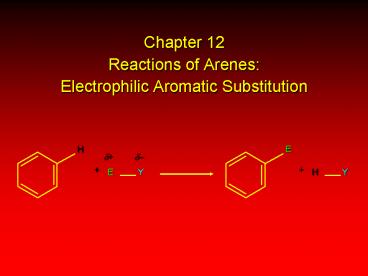Chapter 12 Reactions of Arenes: Electrophilic Aromatic Substitution - PowerPoint PPT Presentation
Title:
Chapter 12 Reactions of Arenes: Electrophilic Aromatic Substitution
Description:
Y. H. Y. d d. 12.1. Representative Electrophilic Aromatic Substitution ... Rearrangements in Friedel-Crafts Alkylation. Carbocations are intermediates. ... – PowerPoint PPT presentation
Number of Views:431
Avg rating:3.0/5.0
Title: Chapter 12 Reactions of Arenes: Electrophilic Aromatic Substitution
1
Chapter 12Reactions of ArenesElectrophilic
Aromatic Substitution
2
12.1Representative Electrophilic Aromatic
Substitution Reactions of Benzene
3
Electrophilic aromatic substitutions include
- Nitration
- Sulfonation
- Halogenation
- Friedel-Crafts Alkylation
- Friedel-Crafts Acylation
4
Table 12.1 Nitration of Benzene
H2SO4
HONO2
H2O
Nitrobenzene(95)
5
Table 12.1 Sulfonation of Benzene
heat
HOSO2OH
H2O
Benzenesulfonic acid(100)
6
Table 12.1 Halogenation of Benzene
FeBr3
Br2
HBr
Bromobenzene(65-75)
7
Table 12.1 Friedel-Crafts Alkylation of Benzene
AlCl3
(CH3)3CCl
HCl
tert-Butylbenzene(60)
8
Table 12.1 Friedel-Crafts Acylation of Benzene
AlCl3
HCl
1-Phenyl-1-propanone(88)
9
12.2Mechanistic PrinciplesofElectrophilic
Aromatic Substitution
10
Step 1 attack of electrophileon p-electron
system of aromatic ring
- highly endothermic
- carbocation is allylic, but not aromatic
11
Step 2 loss of a proton from the
carbocationintermediate
H
H
E
H
H
H
H
E
H
H
H
H
H
H
- highly exothermic
- this step restores aromaticity of ring
12
(No Transcript)
13
Based on this general mechanism
- what remains is to identify the electrophile in
nitration, sulfonation, halogenation,
Friedel-Crafts alkylation, and Friedel-Crafts
acylation to establish the mechanism of specific
electrophilic aromatic substitutions
14
12.3Nitration of Benzene
15
Nitration of Benzene
H2SO4
HONO2
H2O
Electrophile isnitronium ion
16
Step 1 attack of nitronium cationon p-electron
system of aromatic ring
17
Step 2 loss of a proton from the
carbocationintermediate
H
H
NO2
H
H
H
H
NO2
H
H
H
H
H
H
18
Where does nitronium ion come from?
H2SO4
19
12.4Sulfonation of Benzene
20
Sulfonation of Benzene
heat
HOSO2OH
H2O
Several electrophiles present a major one is
sulfur trioxide
21
Step 1 attack of sulfur trioxideon p-electron
system of aromatic ring
22
Step 2 loss of a proton from the
carbocationintermediate
H
H
SO3
H
H
H
H
SO3
H
H
H
H
H
H
23
Step 3 protonation of benzenesulfonate ion
H2SO4
24
12.5Halogenation of Benzene
25
Halogenation of Benzene
FeBr3
Br2
HBr
Electrophile is a Lewis acid-Lewis basecomplex
between FeBr3 and Br2.
26
The Br2-FeBr3 Complex
FeBr3
Lewis base
Lewis acid
Complex
- The Br2-FeBr3 complex is more electrophilic than
Br2 alone.
27
Step 1 attack of Br2-FeBr3 complex on
p-electron system of aromatic ring
Br
Br
FeBr3
H
H
H
H
H
H
FeBr4
28
Step 2 loss of a proton from the
carbocationintermediate
H
H
Br
H
H
H
H
Br
H
H
H
H
H
H
29
12.6Friedel-Crafts Alkylation of Benzene
30
Friedel-Crafts Alkylation of Benzene
AlCl3
(CH3)3CCl
HCl
Electrophile is tert-butyl cation
31
Role of AlCl3
- acts as a Lewis acid to promote ionizationof the
alkyl halide
(CH3)3C
Cl
AlCl3
32
Role of AlCl3
- acts as a Lewis acid to promote ionizationof the
alkyl halide
(CH3)3C
Cl
AlCl3
(CH3)3C
33
Step 1 attack of tert-butyl cationon
p-electron system of aromatic ring
H
H
H
H
H
H
34
Step 2 loss of a proton from the
carbocationintermediate
H
H
C(CH3)3
H
H
H
H
C(CH3)3
H
H
H
H
H
H
35
Rearrangements in Friedel-Crafts Alkylation
- Carbocations are intermediates.
- Therefore, rearrangements can occur
(CH3)2CHCH2Cl
Isobutyl chloride
tert-Butylbenzene(66)
36
Rearrangements in Friedel-Crafts Alkylation
- Isobutyl chloride is the alkyl halide.
- But tert-butyl cation is the electrophile.
(CH3)2CHCH2Cl
Isobutyl chloride
tert-Butylbenzene(66)
37
Rearrangements in Friedel-Crafts Alkylation
H
H3C
C
CH2
CH3
38
Reactions Related to Friedel-Crafts Alkylation
H2SO4
Cyclohexylbenzene(65-68)
- Cyclohexene is protonated by sulfuric acid,
giving cyclohexyl cation which attacks the
benzene ring
39
12.7Friedel-Crafts Acylation of Benzene
40
Friedel-Crafts Acylation of Benzene
O
O
CCH2CH3
AlCl3
CH3CH2CCl
HCl
Electrophile is an acyl cation
41
Step 1 attack of the acyl cationon p-electron
system of aromatic ring
H
H
H
H
H
H
H
H
H
H
H
H
42
Step 2 loss of a proton from the
carbocationintermediate
H
H
H
H
H
H
H
H
H
H
H
H
43
Acid Anhydrides
- can be used instead of acyl chlorides
AlCl3
Acetophenone(76-83)
44
12.8Acylation-Reduction
45
Acylation-Reduction
permits primary alkyl groups to be attachedto an
aromatic ring
RCCl
AlCl3
Zn(Hg), HCl
CH2R
- Reduction of aldehyde and ketonecarbonyl groups
using Zn(Hg) and HCl is called the Clemmensen
reduction.
46
Acylation-Reduction
permits primary alkyl groups to be attachedto an
aromatic ring
RCCl
H2NNH2, KOH,triethylene glycol,heat
AlCl3
- Reduction of aldehyde and ketonecarbonyl groups
by heating with H2NNH2 and KOH is called
theWolff-Kishner reduction.
CH2R
47
Example Prepare isobutylbenzene
(CH3)2CHCH2Cl
CH2CH(CH3)3
AlCl3
- No! Friedel-Crafts alkylation of benzene using
isobutyl chloride fails because of rearrangement.
48
Recall
(CH3)2CHCH2Cl
Isobutyl chloride
tert-Butylbenzene(66)
49
Use Acylation-Reduction Instead
AlCl3
Zn(Hg)HCl































